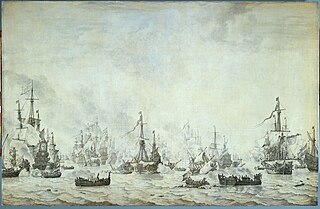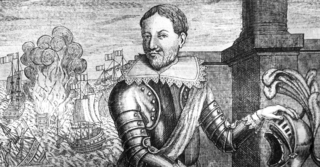Related Research Articles

Piet Pieterszoon Hein was a Dutch admiral and privateer for the Dutch Republic during the Eighty Years' War. Hein was the first and the last to capture a large part of a Spanish treasure fleet which transported huge amounts of gold and silver from Spanish America to Spain. The amount of silver taken was so large that it resulted in the rise of the price of silver worldwide and the near bankruptcy of Spain.

The Battle of the Downs took place on 21 October 1639, during the Eighty Years' War. A Spanish fleet, commanded by Admiral Antonio de Oquendo, was decisively defeated by a Dutch force under Lieutenant-Admiral Maarten Tromp. Victory ended Spanish efforts to re-assert naval control over the English Channel and confirmed Dutch dominance of the sea lanes, while it is also alleged to be the first major action to feature line of battle tactics.

The Anglo-Spanish War (1585–1604) was an intermittent conflict between the Habsburg Kingdom of Spain and the Kingdom of England that was never formally declared. It began with England's military expedition in 1585 to what was then the Spanish Netherlands under the command of Robert Dudley, Earl of Leicester, in support of the Dutch rebellion against Spanish Habsburg rule.
Jacques Colaert or Jacob Collaart was a Flemish privateer who during the Dutch Revolt sailed in royal service as one of the Dunkirkers.

Edward Davis or Davies was an English buccaneer active in the Caribbean during the 1680s and would lead successful raids against Leon and Panama in 1685, the latter considered one of the last major buccaneer raids against a Spanish stronghold. Much of his career was later recorded by writer William Dampier in A New Voyage Round the World (1697).

During the Dutch Revolt (1568–1648), the Dunkirkers or Dunkirk Privateers were commerce raiders in the service of the Spanish monarchy and later the Kingdom of France. They were also part of the Dunkirk fleet, which consequently was a part of the Spanish monarchy's Flemish fleet(Armada de Flandes). The Dunkirkers operated from the ports of the Flemish coast: Nieuwpoort, Ostend, and Dunkirk. Throughout the Eighty Years' War, the fleet of the Dutch Republic repeatedly tried to destroy the Dunkirkers. The first Dunkirkers sailed a group of warships outfitted by the Spanish government, but non-government investment in privateering soon led to a more numerous fleet of privately owned and outfitted warships.

Pierre Jean Van Stabel was a French Navy officer best known for his role in the Glorious First of June.

Jan Jacobsen was a Flemish naval commander and Dunkirker during the Eighty Years' War. He became a posthumous hero when, after battling an enemy fleet for over 13 hours, he destroyed his own ship rather than surrender.
Juan Garcia was a 17th-century Spanish privateer. He was among a number of Spaniards who served the Spanish Crown as Dunkirkers during the Eighty Years' War. Both he and Pedro de la Plesa were caught by the Dutch Republic naval force as they attempted to break through a blockade of Dunkirk. He and de la Plesa were accused of leaving Captain Jan Jacobsen to face nine pursuing Dutch warships alone.
Jan Willems, also known as Janke or Yankey Willems, was a 17th-century Dutch buccaneer. Based out of Petit-Goâve, Willems participated in a number of expeditions against the Spanish during the early to mid-1680s with other well-known privateers including Michiel Andrieszoon, Thomas Paine, Laurens de Graaf, Nicholas van Hoorn and Michel de Grammont.

The Battles of La Naval de Manila or Battle of Manila Bay were a series of five naval battles fought in the waters of the Spanish East Indies in the year 1646, in which the forces of the Spanish Empire repelled various attempts by forces of the Dutch Republic to invade Manila, during the Eighty Years' War. The Spanish forces, which included many native volunteers, consisted of two, and later, three Manila galleons, a galley and four brigantines. They neutralized a Dutch fleet of nineteen warships, divided into three separate squadrons. Heavy damage was inflicted upon the Dutch squadrons by the Spanish forces, forcing the Dutch to abandon their invasion of the Philippines.
Joris Pieters van den Broeck was a Frisian sailor in the service of the Admiralty of Friesland.

The Battle of Gibraltar took place on 10 August 1621, during the Eighty Years' War between the Spanish Empire and the Dutch Republic. A Dutch East India Company fleet, escorted by a squadron under Willem Haultain de Zoete, was intercepted and defeated by nine ships of Spain's Atlantic fleet under Fadrique de Toledo while passing the Strait of Gibraltar.

The Battle of Cape Celidonia took place on 14 July 1616 during the Ottoman–Habsburg struggle for the control of the Mediterranean. During its course, a small Spanish fleet owned by Viceroy of Naples Pedro Téllez-Girón, Duke of Osuna, under the command of Francisco de Rivera, was attacked by an Ottoman fleet that vastly outnumbered it while cruising off Cyprus. Despite this, the Spanish ships, mostly galleons, managed to repel the Ottomans, whose fleet consisted mainly of galleys, inflicting heavy losses.

The Battle of Cape St Vincent of 1641 took place on 4 November 1641 when a Spanish fleet commanded by Don Juan Alonso de Idiáquez y Robles intercepted a Dutch fleet led by Artus Gijsels during the Eighty Years' War. After a fierce battle two Dutch ships were lost but the Dutch claimed only a hundred of their men were killed; the Spanish fleet also lost two ships but over a thousand dead. The damaged Dutch fleet was forced to abandon its planned attack on the Spanish treasure fleet.

The action of 18 February 1639 was a naval battle of the Eighty Years' War fought off Dunkirk between a Dutch fleet under the command of Admiral Maarten Tromp and the Spanish Dunkirk Squadron under Miguel de Horna. Horna, who had orders to join with his ships Admiral Antonio de Oquendo's fleet at A Coruña, escorted at the same time a transport convoy carrying 2,000 Walloon soldiers to Spain, where they were needed. The attempt to exit Dunkirk was done in sight of the Dutch blockading squadron of Maarten Tromp. A 4-hour battle ensued and Horna was forced to retreat into Dunkirk leaving behind two of his galleons, whilst another ran aground. Despite his success in stopping the sortie, many of Tromp's ships suffered heavy damage, and the Dutch Admiral was forced to abandon the blockade. Therefore, De Horna, after repairing his squadron, was able to accomplish his mission.
The action of 12–17 January 1640 was a naval battle between a Dutch fleet and a combined Spanish-Portuguese fleet during the Eighty Years' War. The battle took place on the Brazilian coast off Pernambuco and was an attempt by a fleet consisting of approximately eighty vessels transporting about 5,000 soldiers under the command of Portuguese Admiral Fernando de Mascarenhas to land reinforcements to bolster the Portuguese militia besieging the city of Recife. On 12 January this fleet was intercepted by a Dutch task force of about forty ships commanded by Willem Loos. The ensuing battle lasted with occasional breaks until the evening of 17 January, when the Spanish and Portuguese fleet retreated and sailed away to the north.

Johan Evertsen was a Dutch admiral who was born in the 17th century.

Boudewijn Hendricksz was a Dutch corsair and later Admiral. He is most famous for his role in the Battle of San Juan (1625) during the Eighty Years' War, in which he tried but failed to capture San Juan from Spanish forces. In the same year, prior the assault on San Juan he attempted to recapture Bahia, Brazil after the Spanish overcame Dutch forces in the city.
The Battle of Cabañas was an attempt in 1638 by Dutch privateer Cornelis Jol to capture the Spanish treasure fleet captained by Carlos de Ibarra. The naval battle, framed in the Eighty Years' War, ended with the Dutch fleet retreating after suffering heavy damage.
References
- ↑ Bruyneel, M. (2005). "Privateers and Pirates: Pedro de la Plesa". Isle of Tortuga.